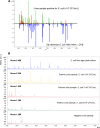Direct identification of urinary tract pathogens from urine samples by matrix-assisted laser desorption ionization-time of flight mass spectrometry
- PMID: 20392910
- PMCID: PMC2884468
- DOI: 10.1128/JCM.02215-09
Direct identification of urinary tract pathogens from urine samples by matrix-assisted laser desorption ionization-time of flight mass spectrometry
Abstract
Matrix-assisted laser desorption ionization-time of flight mass spectrometry (MALDI-TOF MS) has been suggested as a reliable method for bacterial identification from cultures. Direct analysis of clinical samples might increase the usefulness of this method, shortening the time for microorganism identification. We compared conventional methods for the diagnosis of urinary tract infections (UTIs) and identification of the urinary tract pathogens (automated screening, plate cultures, and identification based on biochemical characteristics) and a fast method based on conventional screening and MALDI-TOF MS. For this latter method, 4 ml of urine was centrifuged at a low-revolution setting (2,000 x g) to remove leukocytes and then at high revolutions (15,500 x g) to collect bacteria. The pellet was washed and then applied directly to the MALDI-TOF MS plate. Two hundred sixty urine samples, detected as positive by the screening device (UF-1000i), were processed by culture and MALDI-TOF MS. Twenty samples were positive in the screening device but negative in culture, and all of them were also negative by MALDI-TOF MS. Two-hundred thirty-five samples displayed significant growth of a single morphological type in culture. Two-hundred twenty of them showed bacterial growth of >10(5) CFU/ml. Microorganism identifications in this group were coincident at the species level in 202 cases (91.8%) and at the genus level in 204 cases (92.7%). The most frequent microorganism was Escherichia coli (173 isolates). MALDI-TOF MS identified this microorganism directly from the urine sample in 163 cases (94.2%). Our results show that MALDI-TOF MS allows bacterial identification directly from infected urine in a short time, with high accuracy, and especially when Gram-negative bacteria with high bacterial counts are involved.
Figures
Similar articles
-
Direct identification of bacteria causing urinary tract infections by combining matrix-assisted laser desorption ionization-time of flight mass spectrometry with UF-1000i urine flow cytometry.J Microbiol Methods. 2013 Mar;92(3):231-5. doi: 10.1016/j.mimet.2012.12.016. Epub 2013 Jan 7. J Microbiol Methods. 2013. PMID: 23305925
-
Direct Identification of Urinary Tract Pathogens from Urine Samples, Combining Urine Screening Methods and Matrix-Assisted Laser Desorption Ionization-Time of Flight Mass Spectrometry.J Clin Microbiol. 2016 Apr;54(4):988-93. doi: 10.1128/JCM.02832-15. Epub 2016 Jan 27. J Clin Microbiol. 2016. PMID: 26818668 Free PMC article.
-
Improved bacterial identification directly from urine samples with matrix-assisted laser desorption/ionization time-of-flight mass spectrometry.J Clin Lab Anal. 2018 Mar;32(3):e22301. doi: 10.1002/jcla.22301. Epub 2017 Jul 24. J Clin Lab Anal. 2018. PMID: 28737838 Free PMC article.
-
Peptostreptococcus anaerobius: Pathogenicity, identification, and antimicrobial susceptibility. Review of monobacterial infections and addition of a case of urinary tract infection directly identified from a urine sample by MALDI-TOF MS.Anaerobe. 2021 Dec;72:102461. doi: 10.1016/j.anaerobe.2021.102461. Epub 2021 Oct 7. Anaerobe. 2021. PMID: 34626800 Review.
-
Matrix-assisted laser desorption ionization-time of flight mass spectrometry for the identification of bacteria and yeasts in a clinical microbiological laboratory: a review.Acta Clin Belg. 2011 Jul-Aug;66(4):267-73. doi: 10.2143/ACB.66.4.2062567. Acta Clin Belg. 2011. PMID: 21938981 Review.
Cited by
-
Emerging technologies for the clinical microbiology laboratory.Clin Microbiol Rev. 2014 Oct;27(4):783-822. doi: 10.1128/CMR.00003-14. Clin Microbiol Rev. 2014. PMID: 25278575 Free PMC article. Review.
-
Direct detection of microorganisms in sonicated orthopedic devices after in vitro biofilm production and different processing conditions.Eur J Orthop Surg Traumatol. 2021 Aug;31(6):1113-1120. doi: 10.1007/s00590-020-02856-3. Epub 2021 Jan 4. Eur J Orthop Surg Traumatol. 2021. PMID: 33394140
-
Direct Identification of Urinary Tract Pathogens by MALDI-TOF/TOF Analysis and De Novo Peptide Sequencing.Molecules. 2022 Aug 25;27(17):5461. doi: 10.3390/molecules27175461. Molecules. 2022. PMID: 36080229 Free PMC article.
-
Use of the MALDI BioTyper system and rapid BACpro with MALDI-TOF MS for rapid identification of microorganisms causing bacterial urinary tract infection in feline urine samples.J Vet Med Sci. 2018 Oct 10;80(10):1490-1494. doi: 10.1292/jvms.18-0145. Epub 2018 Aug 9. J Vet Med Sci. 2018. PMID: 30089741 Free PMC article.
-
Mass spectrometry-based microbiological testing for blood stream infection.Clin Proteomics. 2020 May 13;17:14. doi: 10.1186/s12014-020-09278-7. eCollection 2020. Clin Proteomics. 2020. PMID: 32435163 Free PMC article. Review.
References
-
- Blondiaux, N., O. Gaillot, and R. J. Courcol. 2009. MALDI-TOF mass spectrometry to identify clinical bacterial isolates: evaluation in a teaching hospital. Pathol. Biol. (Paris). [Epub ahead of print.] - PubMed
-
- Degand, N., E. Carbonnelle, B. Dauphin, J. L. Beretti. M. Le Bourgeois, Semet-Gaudelus, C. Segonds, P. Berche, X. Nassif, and A. Ferroni. 2008. Matrix-assisted laser desorption ionization-time of flight mass spectrometry for identification of nonfermenting gram-negative bacilli isolated from cystic fibrosis patients. J. Clin. Microbiol. 46:3361-3367. - PMC - PubMed
Publication types
MeSH terms
LinkOut - more resources
Full Text Sources
Other Literature Sources
Medical


